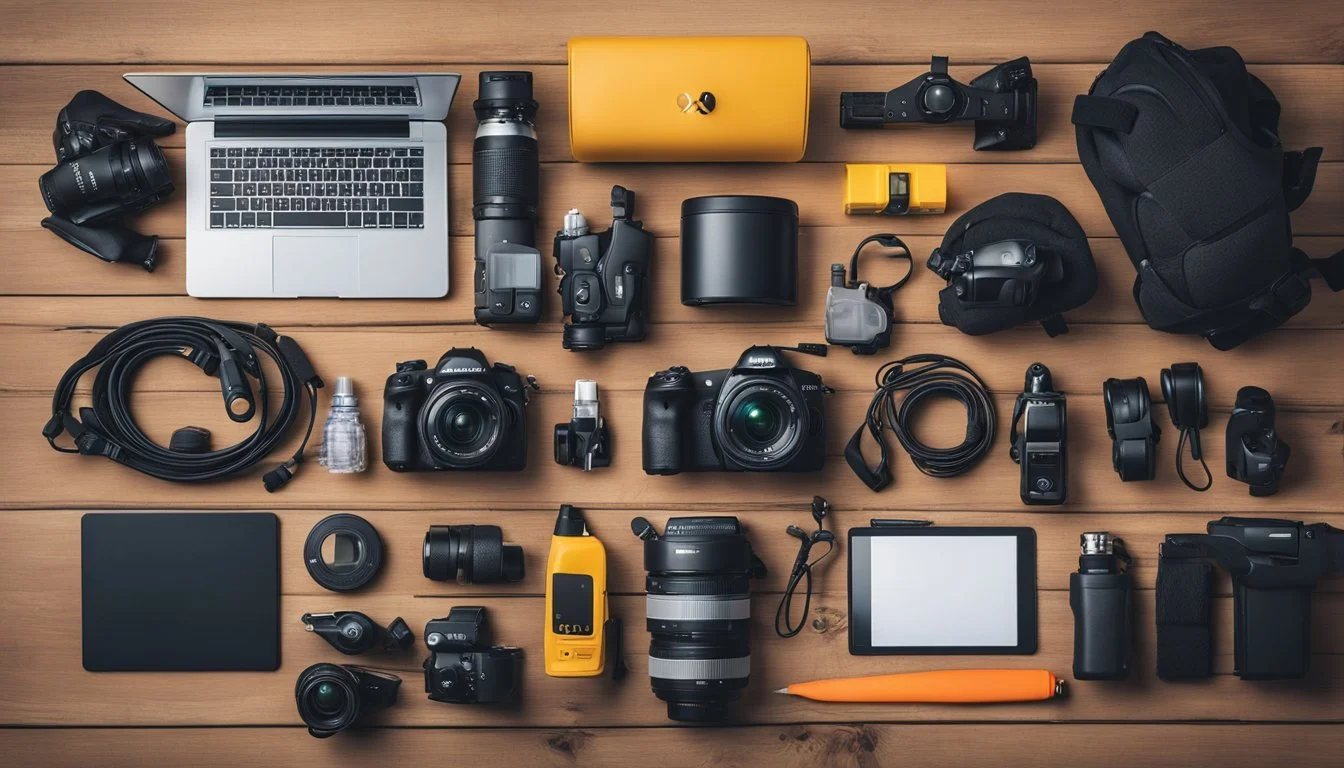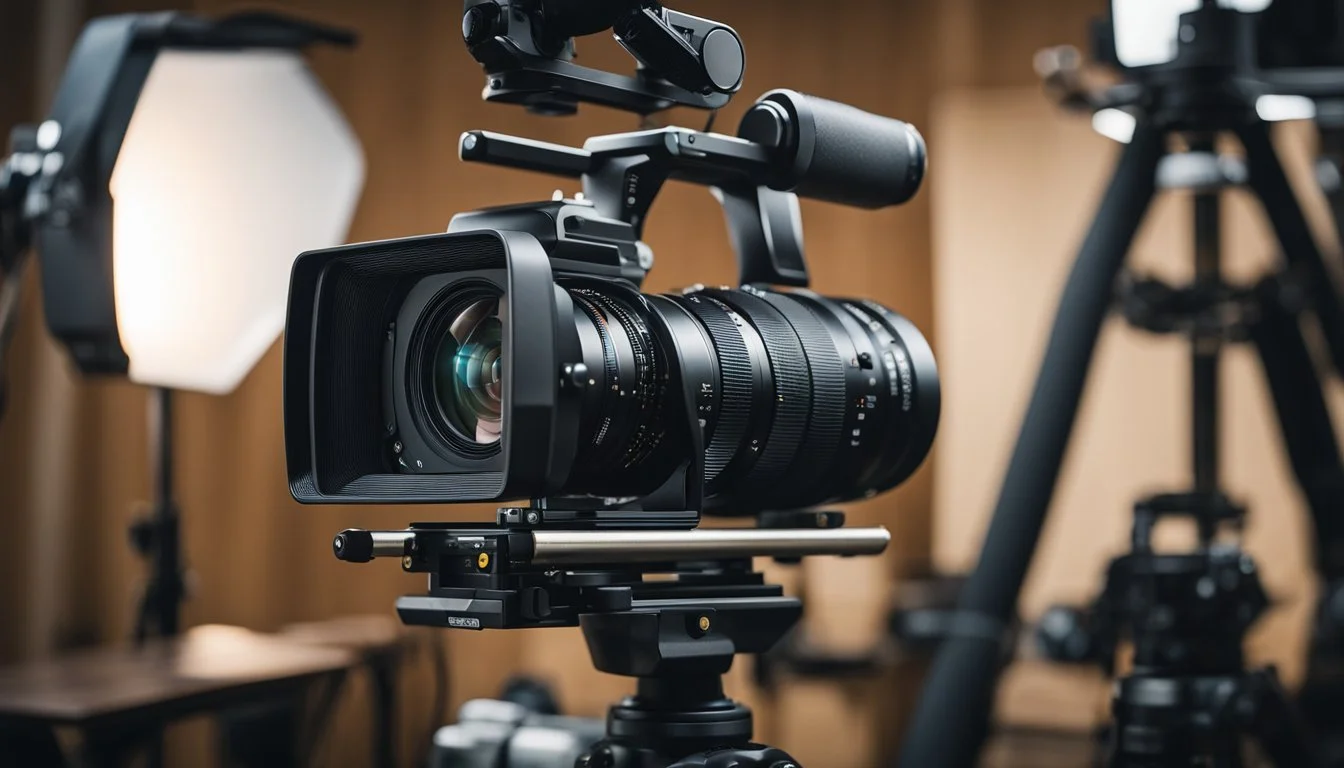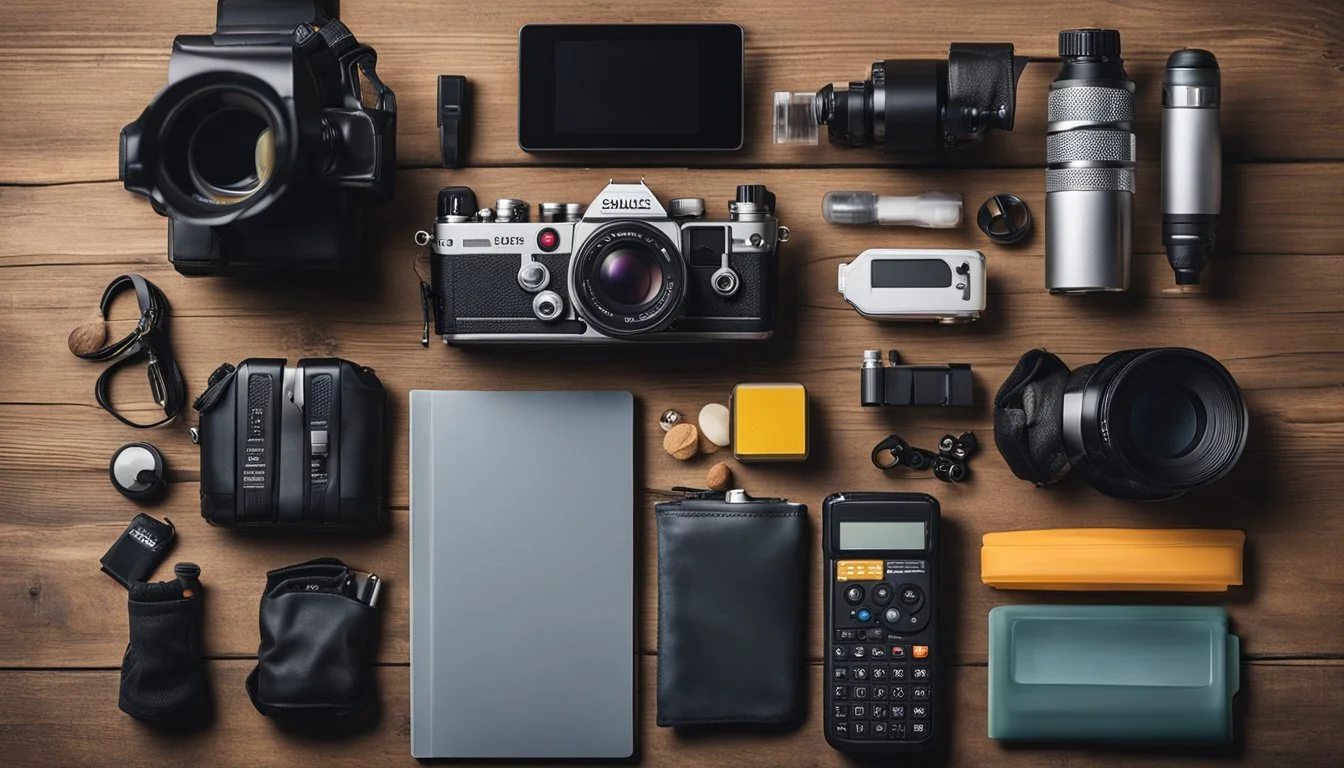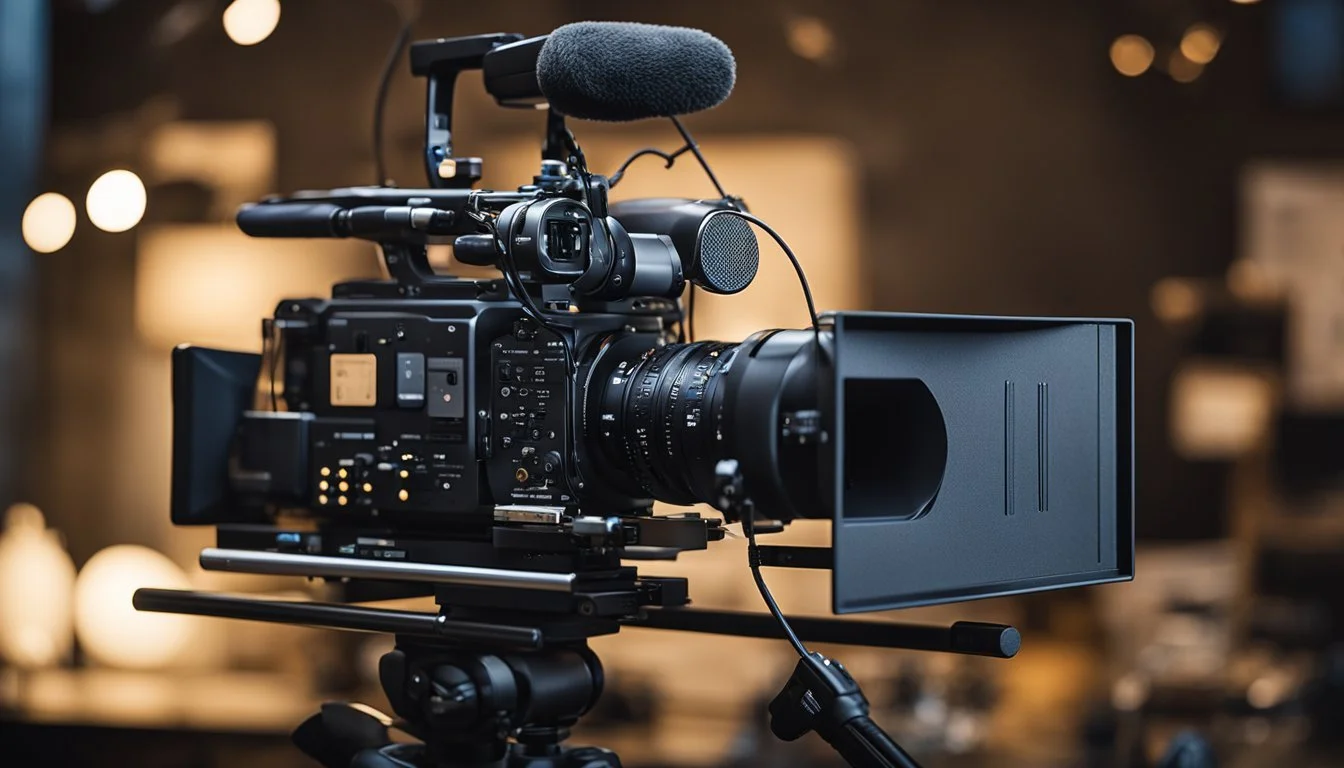14 Essential Items Every Film Crew Member Should Have on Set
Maximizing Efficiency and Comfort
In the high-paced environment of film production, every crew member, whether a gaffer, grip, or electric, needs to be well-prepared with the right tools and gear. These essentials ensure that each task, from setting up lights to handling cameras, is carried out efficiently and safely. Equipping oneself with the right items is not just about convenience; it's about being able to adapt to unexpected challenges and ensuring the smooth functioning of the entire set.
Understanding what gear is essential can significantly improve workflow and productivity. From multitools and screwdrivers to baby pins and portable lighting solutions, each item plays a pivotal role in tackling the diverse requirements of a film set. Whether the film is a big-budget studio production or an independent project, preparedness with the fundamental tools is crucial for the success of the shoot.
1) Clapperboard
A clapperboard, also known as a film slate, is essential for any film crew. It serves to synchronize sound with video during the editing process. The board is struck at the beginning or end of a scene, providing a visual and auditory cue for editors.
The clapperboard usually includes spaces to indicate the scene number, take number, and roll or reel number. These details help keep the production organized and ensure that editors can easily locate and sync specific takes and scenes. The "Head ID" refers to these identifiers.
When using a clapperboard, the assistant director typically calls "roll camera," prompting the first assistant camera to start recording and call out "speed" or "rolling." At this moment, the clapperboard is brought into the frame and sharply focused.
Holding the clapperboard firmly, it's important to clearly state the scene and take numbers. Using the phonetic alphabet can be helpful to avoid confusion with similar-sounding letters. The clap sound marks the beginning of the take, making it easier to align audio and video during post-production.
In addition to aiding in synchronization, the clapperboard also assists in maintaining an efficient workflow on set. Its use helps reduce errors and saves time during the complex editing stage.
2) C-Stand
A C-Stand, or Century Stand, is a crucial tool on any film set. It provides support for lighting equipment and other accessories. Its stability and versatility make it a favorite among grip departments.
Setting up a C-Stand begins with selecting a level surface to prevent tipping. The legs should be fully extended and locked to form a sturdy tripod base.
The largest leg must face the direction of the load for optimal stability. This helps prevent the stand from toppling over when supporting heavy or unevenly distributed weight.
Attaching accessories to the C-Stand requires the main column to be secured to the base. It's important to ensure all twist knobs are tight and oriented correctly. This enhances safety and efficiency during filming.
Using a sandbag on the tallest leg adds extra stability. This is especially useful in windy conditions or when the C-Stand is carrying heavier gear.
In summary, the C-Stand is an essential piece of equipment for maintaining a safe and efficient film set. Setting it up correctly ensures that lighting and accessories remain secure, preventing accidents and ensuring a smooth shoot.
3) Lavalier Microphone
A lavalier microphone, often referred to as a lapel mic, is essential for clear audio capture on set. These small, discreet mics can be clipped onto clothing, typically 6-8 inches below the speaker’s mouth, ensuring optimal sound quality.
Cable management is crucial. Creating a small loop at the base of the mic and securing it with tape can reduce cable noise. This simple step minimizes audio interference and maintains a professional sound.
Lav mics can be wired or wireless. Wired options are generally more budget-friendly, while wireless versions offer greater mobility and ease of movement for the talent. Both types are valued depending on the specific needs of the production.
Securing the microphone properly is key. Using skin-safe adhesive tape helps keep the mic in place and reduces visibility on camera. Routing the wire down the back of the person being miked also helps to keep it hidden from view.
Different brands offer various models suitable for different budgets and requirements. Popular choices include the Rode smartLav+ for wired needs and the Deity V.Lav for entry-level wireless options. Each has its unique features catering to different aspects of film production.
A lavalier microphone is a versatile and necessary tool for capturing professional-grade audio on set. Make sure to include one in your film crew’s essential gear.
4) Gaffer Tape
Gaffer tape is indispensable for any film crew. It was created by lighting designer Ross Lowell specifically for photographers and filmmakers.
This durable tape doesn’t reflect light, making it ideal for securing cables and equipment on set. Its adhesive is strong yet easy to remove, preventing damage to surfaces.
Gaffer tape comes in various colors and widths. The common black tape is great for camouflaging in the background, while white tape is often used for marking and labeling.
Colored gaffer tapes, including spike tape, are frequently employed by the second assistant camera to label actor marks and provide visual cues on set. This tape proves its versatility in every use case.
Gaffer tape’s reliability and adaptability make it a must-have for film crew members. It stands apart from other tapes due to its unique blend of strength and removability.
5) Sandbags
Sandbags are indispensable on any film set. They provide crucial stability to light stands, C-stands, and other equipment. Using sandbags helps to prevent accidents, such as lights tipping over during a shoot.
Crew members often use sandbags to anchor equipment on uneven terrain. They can be placed over the legs of stands or hung from booms to create a counterbalance.
Different weights of sandbags are available, typically ranging from 5 to 25 pounds. The choice depends on the specific needs of the equipment being stabilized. Crew members should ensure that sandbags are filled properly and securely closed to avoid any potential hazards.
Sandbags are versatile and can be used in various situations beyond just stabilizing. They can be employed to keep doors open, as placeholders for marking positions, or even to secure backdrop stands.
Transporting sandbags is relatively straightforward. Many crew members prefer using durable, water-resistant bags for carrying multiple sandbags without risk of tearing or damage. Sandbags are a simple yet vital piece of gear that enhance safety and efficiency on set.
6) Camera Slider
A camera slider is a crucial tool for adding smooth, dynamic movement to your shots. It enables filmmakers to create professional-looking footage without the need for complex setups.
Selecting a camera slider depends on your specific needs. Motorized sliders offer automated control, ideal for intricate shots. Some sliders are compact and designed for smartphones, making them versatile for various filming environments.
When using a camera slider, ensure it's mounted securely. A fluid head mount can add stability and increase the distance between the camera and the slider, enhancing the range of motion. This prevents the slider from entering the frame, especially when using wide-angle lenses.
Consider the slider's build quality and weight capacity. Durable sliders are essential for supporting heavy camera rigs. Lightweight options are beneficial for on-the-go filming but may have limitations in handling heavier equipment.
Choosing the right slider transforms your project, offering seamless movements that elevate your overall production value.
7) Field Monitor
A field monitor provides filmmakers with a clear view of what the camera is capturing.
It allows for better assessment of framing, focus, and exposure in real-time.
This device is crucial for both Directors of Photography (DPs) and camera operators.
Field monitors are typically larger and offer higher resolution than the camera’s built-in screen.
They can be mounted on the camera or used handheld.
They often come with advanced features like LUT support, histograms, and false color.
These features help in achieving precise color grading and exposure settings on set.
Moreover, some field monitors also support wireless video transmission.
This facilitates directors and other crew members to view shots remotely without crowding around the camera.
8) Boom Microphone
A boom microphone is an essential tool for capturing high-quality audio on set. It consists of a microphone mounted on a long pole, known as a boom, allowing the operator to position it close to the sound source without getting in the camera's frame.
Boom microphones come in various types, including shotgun and dynamic mics. Shotgun mics are highly directional, making them ideal for isolating dialogue amidst background noise. Dynamic mics, on the other hand, are more versatile and robust, suitable for various environmental conditions.
The boom operator plays a critical role in maneuvering the microphone to capture clear audio. This involves holding the boom pole steadily for extended periods, often under challenging conditions. The operator must also anticipate actors' movements and adjust the microphone position accordingly.
Selecting the right boom microphone is crucial. Factors to consider include the environment, the type of production, and the specific audio needs. Lightweight and ergonomic boom poles are preferred for their ease of handling.
To achieve the best results, the microphone should be positioned within three feet of the subject. This proximity helps capture crisp, clear sound, whether the scene is shot indoors or outdoors. Sound quality can significantly impact the production's overall success, making a high-quality boom microphone indispensable on set.
9) Follow Focus
Follow focus is crucial for cinematographers aiming to maintain sharp, consistent focus on moving subjects.
This system allows operators and assistants to control a camera lens's focus using gears and knobs.
By enabling smooth transitions between different focal planes, follow focus ensures the intended subject remains in clear focus throughout each shot.
Film crew members must be proficient in this technique to achieve high-quality visuals during production.
10) V-Mount Battery
A V-Mount battery, also known as a V-Lock or V-Mount battery, is a staple for any film crew member working with electronic devices, especially cameras. It provides a reliable, rechargeable lithium-ion power source.
The distinct V-shaped design ensures secure mounting and easy detachment from cameras and other equipment. This design enhances efficiency on set by allowing quick battery changes.
With a typical voltage of around 7.0V, V-Mount batteries are designed to be compatible with various cameras and other devices. This compatibility helps avoid performance issues or camera shutdowns due to power inconsistencies.
V-Mount batteries come in different capacities, catering to the needs of extended shoots. Advanced versions, like the SmallRig VB155 mini V-Mount Battery, offer compact designs, intelligent fast charging, and battery protection systems.
For productions, big or small, V-Mount batteries provide a versatile and indispensable solution. Their ability to maintain power throughout long shooting days makes them an essential item for any film crew member.
11) Light Meter
A light meter is an indispensable tool for achieving accurate exposure in both film and digital photography. It measures the amount of light in a scene and suggests the optimal exposure settings in terms of shutter speed, aperture, and ISO.
There are two main types of light meters: incident and reflective. Incident light meters measure the light falling directly onto the subject, while reflective meters measure the light reflecting off the subject.
Using a light meter is straightforward. Position the meter at the subject's location with the lumisphere facing the camera lens. This ensures accurate measurement of the light falling on the subject.
Modern light meters have features to switch between ambient and flash modes, aiding in various lighting scenarios. Accurate light measurement helps in maintaining consistent exposure across multiple shots, crucial for film continuity.
TTL (Through-The-Lens) metering is an alternative found in many cameras. However, handheld light meters often provide more precise control, especially in complex lighting conditions.
For a film crew member, mastering the light meter is pivotal. It removes guesswork and enhances the quality of the shot, making it an essential tool every crew should carry.
12) Pelican Case
A Pelican case is a must-have for any film crew member. Known for its rugged durability, the Pelican case offers unparalleled protection for delicate equipment such as cameras, lenses, and sound gear.
Pelican cases come in various sizes, catering to different types of gear. Small options might fit essential items like microphones and batteries, while larger ones can house lighting equipment or larger camera setups.
These cases are also watertight and dustproof, providing security against environmental hazards on set. The built-in pressure equalization valve prevents vacuum lock, making it easier to open the case after long flights.
An additional benefit is the customizable foam inserts. These can be tailored to snugly fit any equipment, ensuring everything remains in place during transit. Whether traveling by car or plane, a Pelican case keeps gear safe.
Their ergonomic design includes comfortable handles and secure latches. Despite their sturdy build, these cases are relatively lightweight, which is crucial when managing weight limits during air travel.
Lastly, Pelican cases also offer a high degree of versatility. They can be used to store and protect not just film gear but also laptops, drones, or any other valuable electronics. The robust protection they provide makes them indispensable on set.
13) Zoom H6 Recorder
The Zoom H6 Recorder is a crucial tool for any film crew. It is known for its robust and versatile recording capabilities, making it suitable for various on-set audio needs.
This handheld recorder offers six tracks of 32-bit float recording. This high-resolution format ensures the best possible audio quality, even at low volumes. The device's ability to handle different recording scenarios makes it indispensable.
Inputs 1-4 on the H6 have independent PAD switches, allowing them to manage +4dB input levels. This feature is particularly useful when capturing audio from different sources without distortion.
The Zoom H6 Recorder also supports wireless control when paired with the BTA-1 adapter and a compatible smartphone or tablet app. This allows crew members to monitor and adjust settings remotely.
Its ergonomic design ensures ease of use during long shooting days. The device's user-friendly interface, along with its robust build, makes it reliable in various recording environments.
Overall, the Zoom H6 Recorder's advanced features and versatility make it an essential item for any film crew member dedicated to capturing high-quality audio on set.
14) Sony A7S III
The Sony A7S III is a favored choice among filmmakers for its exceptional video capabilities. It records UHD 4K footage at up to 120 frames per second with 10-bit 4:2:2 encoding, providing remarkable video quality.
Equipped with the NP-FZ100 battery, it offers about 2 hours and 40 minutes of recording time at 4K 24p. A single 256GB SD card allows for up to 9 hours of 4K 24p recording due to the efficient codec.
The camera's autofocus system stands out for its accuracy and flexibility, featuring a flexible focus spot and joystick for quick adjustments. This system ensures sharp focus even in dynamic shooting environments.
The A7S III includes a 16-bit Raw video output, which is significant for those looking for superior post-production flexibility. Filmmakers appreciate its revised user interface, which enhances ease of navigation and operation on set.
Filmmakers often pair the Sony A7S III with essential accessories like the SmallRig Full Cage for added protection and versatility. Including this camera in the equipment list of any film crew ensures high-quality footage with professional standards.
Understanding the Role of Each Film Crew Member
Each film crew member plays a critical role in bringing a production to life. From overseeing creative vision to handling technical aspects, the roles of Director, Producer, and Camera Operator are essential to the filmmaking process.
Director
The Director is the creative leader of a film. They translate the script into visual storytelling by guiding actors, deciding on camera angles, and working closely with the production team to achieve the desired look and feel of the film. During pre-production, the Director collaborates with the screenwriter to refine the script and conducts rehearsals with the cast. On set, the Director oversees the entire shooting process, ensuring each scene aligns with their creative vision. They also work in post-production to shape the final cut of the film.
Producer
The Producer manages the financial and logistical aspects of a film. They are involved from the project's inception through to its completion, ensuring that the production stays on budget and on schedule. In pre-production, Producers secure funding, hire key crew members, and arrange distribution deals. During filming, they solve any problems that arise, be it budgetary issues or logistics. Producers also oversee post-production tasks like editing, marketing, and distribution. They collaborate with both the creative and technical teams to ensure the project’s success.
Camera Operator
The Camera Operator is responsible for capturing the visual elements of the film as per the Director's vision. They work closely with the Director and Director of Photography (DP) to execute the film's visual style. During principal photography, they manage camera equipment and frame shots, ensuring smooth and accurately captured movements. Camera Operators sometimes oversee additional camera staff such as first and second assistants (ACs) who help with technical tasks like focus pulling and camera setup. Their work is crucial in translating the written script into compelling visual sequences.
Importance of Each Essential Item on Set
Having the right tools and supplies ensures a film set operates smoothly, enhances crew safety, and boosts efficiency. Essential items can address potentially time-consuming or dangerous situations swiftly.
Ensuring Smooth Production Workflow
Efficient workflow on a film set relies on having the right tools readily available. Items like the Leatherman Skeletool are versatile for quick fixes. Production stalls without proper lighting, making tools like the 6-inch baby pin crucial for mounting lights.
Proper hydration keeps the crew alert. Coffee and water are fundamental. Without them, productivity dips significantly. A manual can opener allows for accessibility during mealtime, preventing unnecessary delays.
Maintaining a neat workspace is essential. A Carhartt Work Pocket helps grips and gaffers carry tools effortlessly, minimizing workspace clutter and retrieval time.
Enhancing Safety and Efficiency
Safety on set cannot be compromised. Essential items like a waterproof flashlight or headlamp are critical for visibility in dark or poorly lit situations, averting potential hazards. Additional batteries ensure these tools are always operational.
Having a first-aid kit on hand can address minor injuries swiftly, maintaining the crew's health and ability to work. Waterproof matches provide a reliable fire starting method needed in emergencies, especially in adverse weather.
Ensuring each crew member stays refreshed and nourished is vital for sustained energy levels and focus. Nutritious snacks and sufficient water are non-negotiable, preventing dehydration and fatigue that can lead to accidents.






